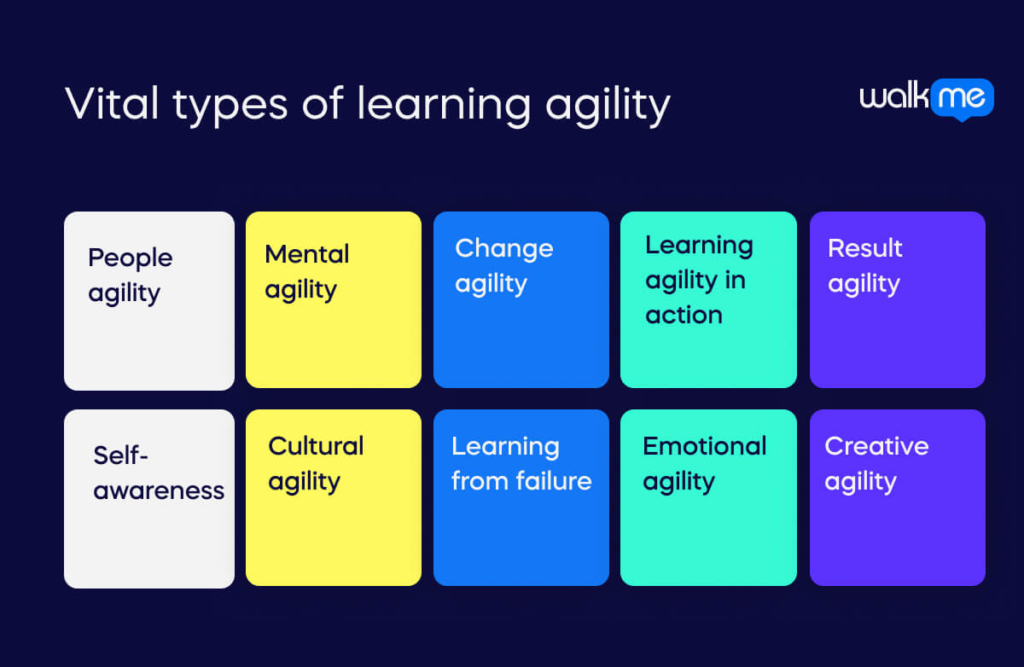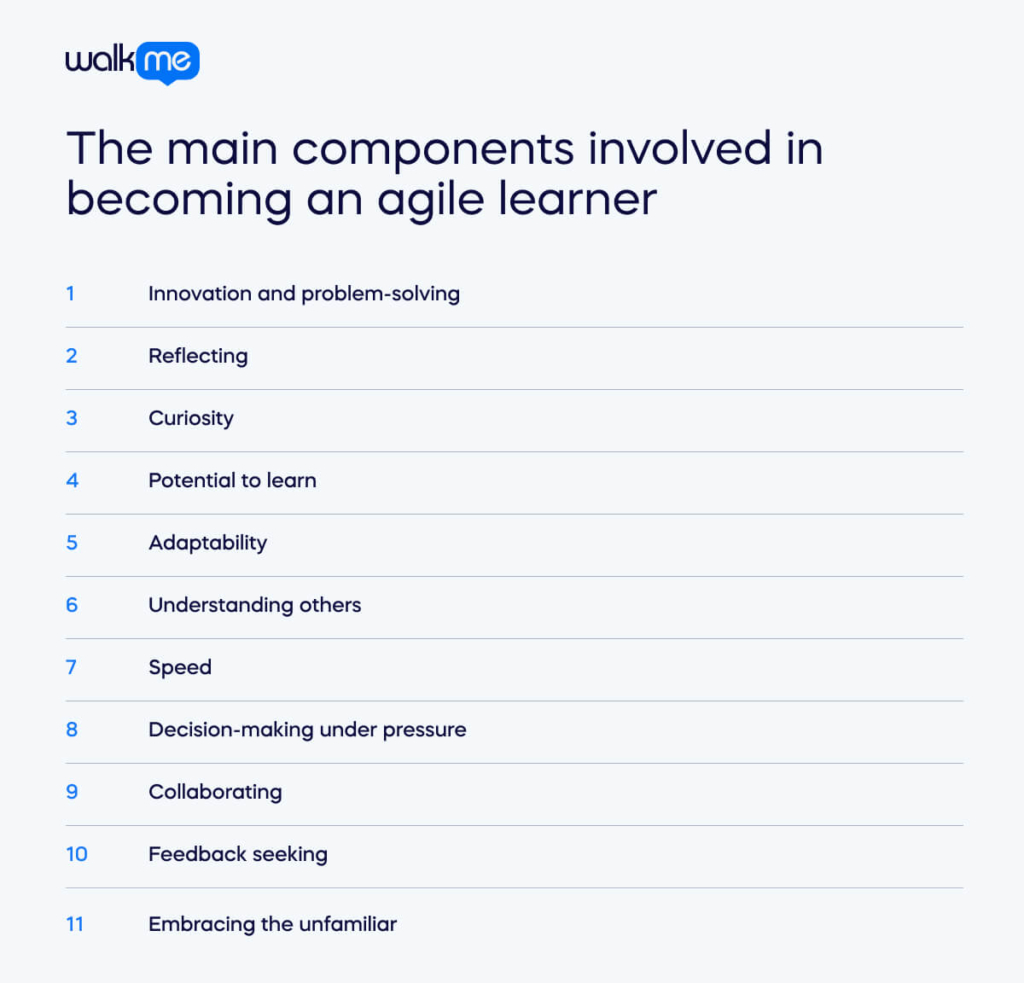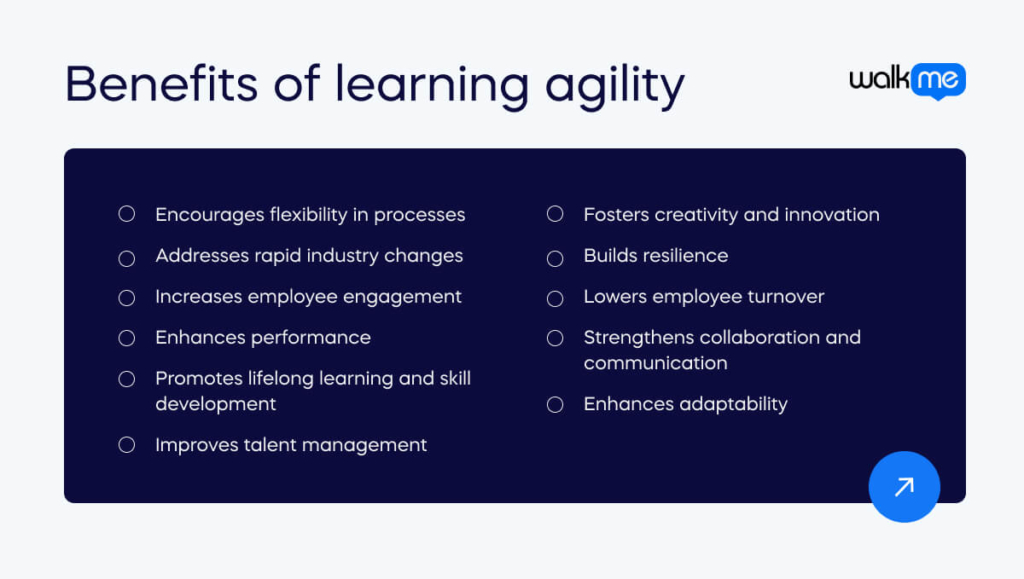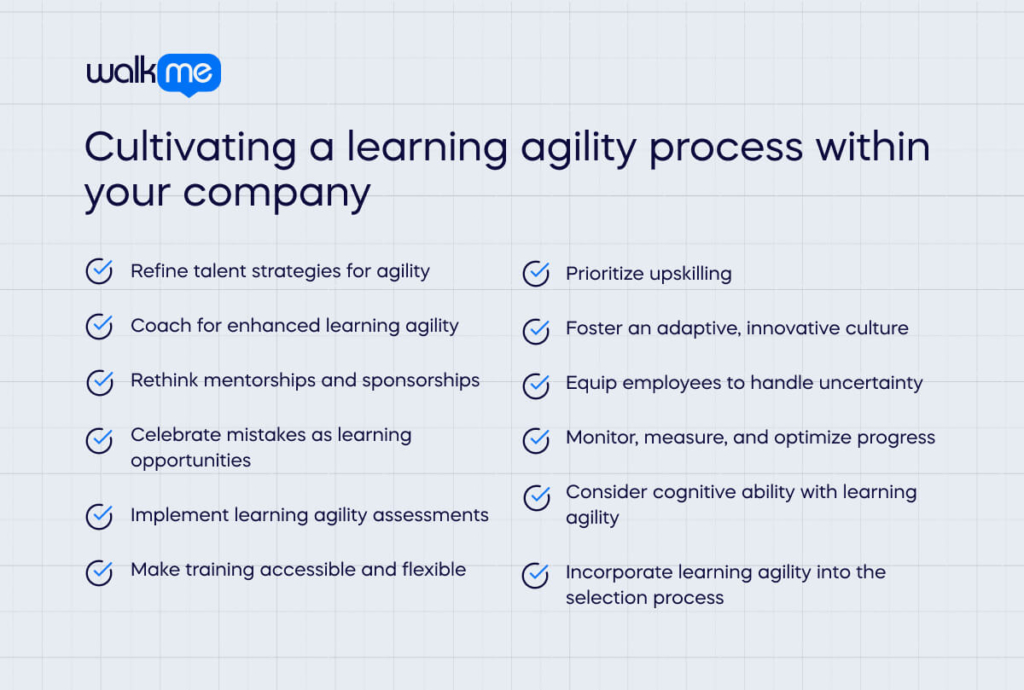Organizations around the globe are consistently striving to leverage digital technology and data for their survival. However, the path to digital maturity is often overwhelming for many companies due to its complex, ever-evolving nature.
This rapidly changing landscape requires leaders to exhibit unprecedented levels of agility.
A survey involving 1,500 executives across 90 countries revealed a telling statistic: 71 percent believe adaptability is the key leadership trait in modern times.
Adaptability forms a crucial part of learning agility.
This term encompasses individuals adept at adjusting and learning in fluctuating conditions. They use their insight and intuition for critical and creative thinking, implementing appropriate solutions for problems.
Consequently, learning agility has become a pivotal focus for numerous organizations that aim to instill a learning culture in their workforce and help them adapt confidently to unpredictable market dynamics.
By the end of this article, you will know:
- What learning agility is and why it is vital for the workplace.
- The various types of learning agility and the traits that make an agile learner.
- The benefits of learning agility.
- How learning agility can be improved and what you can do to create a learning agility process within your organization.
What is learning agility?
Learning agility refers to an individual’s capacity to constantly evolve based on their experiences, adjust to novel scenarios, and embrace diverse perspectives. This concept involves a variety of abilities that enable a person to stay adaptable in a professional setting and question established norms.
Employers often value learning agility as it signifies a prospective employee’s dedication to innovation and effectiveness in team settings. It’s about finding solutions in unfamiliar situations by drawing upon past and present experiences to interpret ambiguous circumstances.
Being an agile learner also means being receptive to fresh ideas and focusing on innovation over outdated practices. Agile learners are comfortable with disruptive change and actively seek new challenges. They value feedback as a means to learn, evolve, and self-reflect.
Such learners possess a mindset geared towards continuous learning. They continuously enhance their understanding and apply new strategies acquired along the way. This prepares them to handle future challenges adeptly.
Why is learning agility important?
Fostering a culture of learning agility is essential for leaders and their teams. It enables them to extract valuable lessons from experiences, particularly in challenging circumstances, thereby enhancing their ability to navigate difficulties effectively.
For an individual, possessing agile learning skills is highly advantageous, enabling quick thinking and adequate decision-making in uncertain situations.
An agile organization capable of swiftly adapting to change is invaluable. This is particularly true when the team has the necessary skills for such adaptability.
From this perspective, agile learning and skills development are crucial for a business’s long-term success.
Consequently, leaders in charge of people management prioritize workforce education and various learning and development (L&D) initiatives as critical components of their broader business strategy.
Vital types of learning agility

Learning agility encompasses various types, each contributing to an individual’s ability to succeed in a dynamic and unpredictable environment.
Here are some key forms of learning agility:
People agility
This involves skills like effective communication, interpersonal relations, and leadership. People with high emotional intelligence who excel at bringing out the best in others often possess people agility.
They are sought after in crises for their ability to build a resilient workforce and handle challenging scenarios, making them preferred choices for roles like mock calls or stress testing. These individuals are adept at resolving conflicts, collaborating effectively, and gaining insights from diverse viewpoints.
Mental agility
Mentally agile individuals are curious and open to new learning, constantly seeking different perspectives. They are proactive in asking questions and are receptive to answers, acknowledging that their knowledge is not all-encompassing.
Change agility
Those with high change agility actively seek novel experiences. They are innovators, comfortable with the dynamics of change in organizations, and often initiate low-cost or no-cost pilot projects to test new ideas.
Learning agility in action
This type focuses on the practical application of knowledge and skills. Individuals with this agility can transfer their learning to real-life scenarios and modify their strategies to fit specific contexts.
Result agility
Individuals with result agility consistently deliver in new or challenging situations. They remain composed under pressure and persistently achieve goals, even in unfamiliar scenarios.
Self-awareness
Essential for learning agility, self-awareness involves being open to feedback while recognizing your strengths and weaknesses so that you can use it for self-improvement. It’s fundamental to understanding the need for a change process.
Cultural agility
This refers to navigating and collaborating effectively in diverse cultural settings. It encompasses an understanding and respect for different cultural norms and practices.
Learning from failure
This agility involves viewing failures as growth opportunities. Individuals adept at this learn from their mistakes, derive insights, and apply these lessons to future efforts.
Emotional agility
Emotional agility is about managing emotions to navigate challenges and build positive relationships. It includes controlling emotional reactions, demonstrating empathy, and fostering constructive interactions.
Creative agility
This type of agility is characterized by thinking innovatively and always generating novel ideas and solutions.
Individuals possessing creative agility excel at approaching challenges with a fresh perspective, utilizing originality, and embracing unconventional problem-solving methods.
The main components involved in becoming an agile learner

We can nurture agile learning in individuals, recognizing that everyone has a unique learning style.
Those with a high potential for learning agility demonstrate specific characteristics indicative of their ability to actively seek, assimilate, and implement new knowledge.
You can also measure an individual’s learning agility based on whether they display these characteristics.
Among these traits are:
Innovation and problem-solving
A hallmark of agile learners is their willingness to face challenges head-on, viewing them as opportunities for growth and innovation.
For instance, when a significant technical problem threatens a product launch, an agile learner on the team might perceive this not as an overwhelming obstacle but as an opportunity to excel.
Such individuals delve into the issue, exploring various potential solutions, and often devise innovative strategies that resolve the immediate problem and enhance the product’s overall functionality.
This capacity for creative problem-solving and thinking outside conventional frameworks makes agile learners invaluable in roles that require innovative solutions.
Reflecting
Reflecting involves taking the time to assess one’s performance to enhance effectiveness. It’s about considering positive and negative feedback, acting upon it, and adjusting behaviors to become future-ready.
Curiosity
Curious individuals ask numerous questions, actively seek learning opportunities, and strive to understand the broader impact of their work. They are confident when faced with the unfamiliar and embrace new experiences without being daunted.
For instance, an agile learner starting a new job would view this challenge as an exciting opportunity for growth. They would bring fresh perspectives, ask insightful questions, and leverage the learning experience to foster positive change.
Potential to learn
The skills that are effective in a current role may not suffice tomorrow. Agile learners remain open, continually seeking new experiences to achieve evolving goals.
Adaptability
Adaptable individuals can effectively use both new and existing tools. They understand current operations well, providing a solid foundation for acquiring future skills.
Understanding others
Agile learners excel in empathy and anticipating different viewpoints. They can connect disparate ideas, identify and resolve potential conflicts, and adopt a broader perspective. They proactively seek diverse opinions and remain open-minded in their approach.
Speed
This involves acting swiftly on ideas, discarding ineffective ones, and accelerating viable alternatives. This agility enables quicker pivots and faster growth.
Decision-making under pressure
Agile learners are adept at making critical decisions calmly and confidently. They process complex information rapidly and think on their feet.
For example, a project manager facing tight deadlines, a reduced workforce, and increased client demands would reassess the situation, reallocate resources, renegotiate project terms, and devise a new strategy, demonstrating their ability to make sound decisions under pressure.
Collaborating
This entails finding collaborative approaches that create unique learning opportunities. Effectively working with diverse styles demonstrates empathy and a readiness to do whatever it takes to drive organizational transformation.
Feedback seeking
Actively seeking feedback on ideas and performance is crucial. Willingness to receive and act on feedback is critical to enhancing learning capabilities.
Embracing the unfamiliar
A fundamental aspect of learning agility is the willingness to enter unfamiliar environments and embrace new experiences.
Agile learners are characterized by their curiosity, sense of adventure, and comfort in taking calculated risks. They favor risks that present real opportunities for growth rather than mere thrill-seeking.
Such individuals are unafraid to volunteer for tasks and roles where outcomes are uncertain and even where failure is a potential outcome.
Learning-agile people seize every chance to learn, continually pushing themselves beyond their comfort zones. This approach builds their confidence and fosters continuous improvement and success.
Benefits of learning agility

Learning agility is increasingly recognized as a key component in education and professional development, offering numerous benefits that align with today’s fast-paced, ever-changing world. Here are some of its advantages:
Encourages flexibility in processes
Being adaptable and flexible, learning-agile employees can identify when traditional processes don’t fit new situations. Assessing learning agility helps pinpoint individuals who can effectively lead a successful workplace transformation.
Addresses rapid industry changes
As industries and job markets evolve, there’s a growing need for workers with diverse skill sets. Learning agility enables individuals to learn new skills quickly, respond to industry shifts, and maintain employability despite economic and technological changes.
Increases employee engagement
Learning agility is closely linked to a continual desire for growth and learning, leading to higher employee engagement. Engaged employees feel challenged and valued, boosting productivity and positively impacting organizational culture.
Enhances performance
Assessing learning agility offers insights into an individual’s skill to pick up and put into practice new knowledge and skills, guiding efforts to improve business performance, productivity, and adaptability.
Promotes lifelong learning and skill development
In the current knowledge-driven economy, lifelong learning is essential. Learning agility fosters a mindset of ongoing improvement, encouraging continuous skill and knowledge acquisition, which is necessary for adapting to new job roles.
Improves talent management
Evaluating learning agility during recruitment and hiring processes aids in identifying candidates likely to drive organizational success.
Fosters creativity and innovation
Environments that encourage learning agility are conducive to creativity and innovation. This freedom to explore and experiment leads to novel solutions and ideas, crucial for societal progress.
Builds resilience
Agile learners quickly recover from setbacks, learn from mistakes, and apply this learning to future challenges. This ability enhances organizational resilience.
Lowers employee turnover
Understanding learning agility helps identify employees who will prosper in dynamic environments and those who require additional support. Targeted adaptive learning platforms can thus reduce turnover and retain top talent.
Strengthens collaboration and communication
Learning agility emphasizes collaborative learning, improving communication skills, and fostering a supportive community. This mirrors the collaborative nature of many modern workplaces.
Enhances adaptability
Highly agile learners adeptly adjust to changes, excel in complex situations, and handle ambiguity well. This adaptability benefits individuals and creates a more flexible and adaptable organizational culture.
Improving learning agility within a workplace
Learning agility is a capability that can be developed at any stage of life, much like strengthening a muscle through consistent exercise.
To enhance your learning agility, consider implementing the following strategies:
Embrace new challenges
Tackle a new challenge that intimidates you, choosing something meaningful but where failure won’t lead to severe personal consequences. Share your goals with others, seeking their help and support.
Stay organized
Ease your transition to learning agility by setting clear goals, establishing guiding principles, planning your approach, and tracking progress. Organized agile learners adapt more effortlessly and often achieve superior results.
Practice self-awareness
Reflect on how you want to be perceived in situations requiring learning agility. Choose three descriptors you aspire to, like confident, calm, and strategic. Solicit feedback to align your intended and actual impacts and address any discrepancies.
Seek continuous improvement
Focus on the development of hard and soft skills and industry knowledge. Utilize training opportunities, join professional organizations, attend conferences, and read expert literature.
Diversify your sources to enhance information validation skills and exposure to different perspectives.
Innovate in problem-solving
Regularly brainstorm unconventional solutions to problems, challenging the status quo. Ask yourself about barriers to innovation and how you would approach the situation if these barriers were absent.
Adopt an active approach
Dive into new challenges head-on. Be curious, experiment, and ask questions like “Why?”, “How?” and “Why not?”
Active listening
Listen attentively to understand others fully, trusting your ability to respond appropriately once they finish speaking.
Manage stress effectively
When stressed, pause instead of reacting impulsively. Consider the most appropriate course of action.
Elevate sense-making
Employ various techniques, engage different senses, and leverage your emotions to gain deeper insights and understanding, especially in complex situations.
Developing heightened sense-making is crucial for potential leaders.
Draw on past experiences
When encountering something new, look for parallels with past experiences. Use these similarities to navigate the new challenge.
Ask questions for understanding
Pose questions aimed at gaining understanding, not just to be heard. Focus on genuinely hearing what others say, building your response based on their input.
Pause and reflect in stressful situations
In moments of stress, avoid immediate reactions. Take time to contemplate what is genuinely required before responding.
Cultivating a learning agility process within your company

By identifying and enhancing enterprise-wide learning agility and adopting an agility-focused approach to talent management, business leaders can build a workforce that aligns with strategic priorities, successfully navigates a volatile business landscape, and drives performance by placing highly agile leaders in critical roles.
HR professionals are pivotal in crafting a learning agility roadmap within the organization.
Here are some essential practices to consider:
Refine talent strategies for agility
Start by determining the organization’s current level of agility. Understand business needs to assess and maximize talent, placing agile leaders in pivotal roles and developing potential while seeking external talent to fill gaps.
Coach for enhanced learning agility
Learning agility can be developed. Provide support and feedback to help individuals understand their agility baseline and offer coaching and workplace opportunities, like an onboarding buddy program, to expand their agility.
Rethink mentorships and sponsorships
Revitalize mentorship and sponsorship programs to offer direct, practical training and feedback. This will prepare employees for future roles and enhance their comfort with new challenges, thereby boosting learning agility.
Celebrate mistakes as learning opportunities
Develop an environment where mistakes are viewed as chances to learn. Recognize and reward behaviors that demonstrate learning from errors, encourage risk-taking, and reduce defensiveness.
Implement learning agility assessments
Use validated tools like the Mettl Learning Agility Assessment, HFM Talent Index Learning Agility Assessment, or IBM’s Learning Agility Assessment to evaluate employees. Complement this with evaluations of emotional intelligence and performance to comprehensively understand each individual’s agility.
Make training accessible and flexible
Provide diverse, easily accessible learning options that cater to various learning styles and are adaptable to hybrid and remote work environments.
Prioritize upskilling
Offer learning opportunities that allow employees to build upon existing skills towards larger goals, like degrees or certifications, in manageable segments.
This could encompass a variety of formats, such as workshops, webinars, online courses, and corporate training sessions. Workshops offer interactive and cooperative settings ideal for experiential learning.
Webinars and online courses provide the advantage of flexible learning tailored to individual schedules and paces. Practical training provides direct experience, allowing employees to immediately apply new skills in their professional contexts.
Foster an adaptive, innovative culture
Encourage a culture that views change positively, values innovative thinking, and supports continuous learning through recognition, knowledge sharing, and an inclusive environment.
Equip employees to handle uncertainty
Help employees become comfortable with uncertainty through practical training programs involving job shadowing, rotations, and temporary assignments, coupled with courses on systematic problem-solving.
Monitor, measure, and optimize progress
Check-in regularly with employees to assess progress in learning to be more agile and continuously identify new ways to apply their learning on the job.
For instance, are individuals proactively taking charge in unfamiliar scenarios? Is leadership adept at anticipating challenges and making timely, necessary decisions?
Utilizing appropriate employee performance metrics can help answer these questions and offer data-driven feedback to address performance shortcomings.
Consider cognitive ability with learning agility
Pair learning agility assessments with cognitive ability tests to form a robust evaluation method for candidates and current employees.
Incorporate learning agility into the selection process
A study has shown that learning agility is a good way of assessing an individual’s ability to excel in their current and future professional positions.
So, during interviews, it is vital to assess candidates’ learning agility through questions about feedback reception, interactions with others, tackling new problems, and achieving results in previous roles.
You should seek responses that exemplify the core behaviors of learning agility, such as actively seeking feedback, taking interpersonal risks, engaging in collaboration, experimenting, reflecting, and exhibiting both speed and flexibility.
You can also utilize personality tests from providers like Truity, 16 Personalities, or Big Five.
What’s next for learning agility in your organization?
Learning agility is vital for empowerment in an ever-changing world where the only certainty is change.
It transcends being merely a skill; it represents a mindset, a philosophy that inspires individuals to perceive challenges as opportunities, to greet uncertainty with curiosity, and to push boundaries for personal and professional growth with zeal.
Learning agility is an essential element in the toolkit of any successful leader.
The capacity and willingness to learn from experiences significantly influence our personal development and others’ perceptions of us. Ultimately, our ability to persistently learn and adapt is critical to our success in these turbulent times.
We can all strive to enhance our learning agility. This involves taking more risks, questioning established norms, and staying engaged in the present while also reflecting on past experiences.
Importantly, this process includes maintaining openness and avoiding defensiveness when faced with criticism or other challenges.
The degree to which we can embrace these practices impacts our current selves and shapes who we can become in the future. We will invariably encounter new challenges, problems, and issues.
The key differentiator between those who were once thriving and those who continue to succeed is their ability to confront these challenges head-on and carry the lessons learned into the future.

